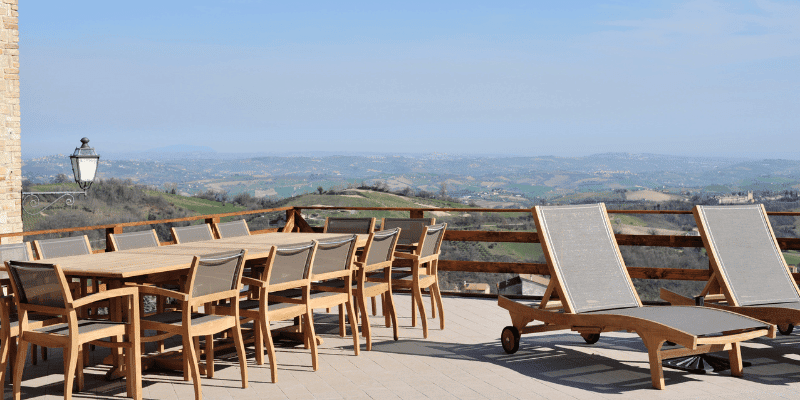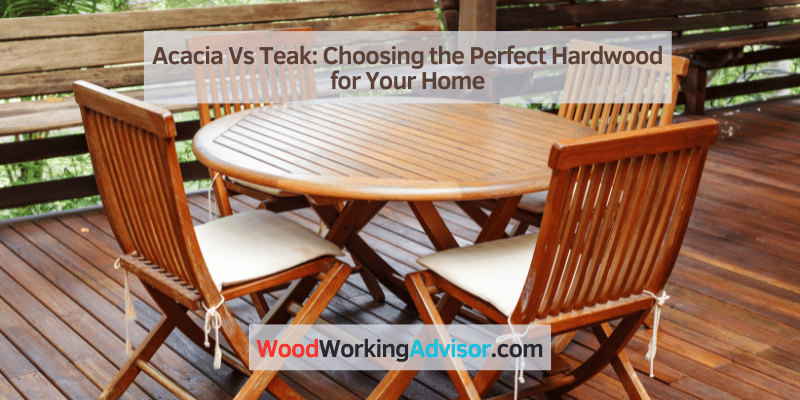Acacia and teak are both durable hardwoods used in furniture and flooring. Each has unique characteristics and benefits, making them suitable for different applications.
Acacia wood, known for its durability and natural resistance to pests, is a popular choice for outdoor furniture and flooring. Teak, on the other hand, is highly valued for its natural oils that make it resistant to moisture, rot, and insects.
Its rich color and smooth texture make it a popular choice for indoor furniture and boat building. Understanding the differences between acacia and teak wood can help you make an informed decision when choosing the right material for your project. We will explore the key differences and advantages of acacia and teak wood, helping you determine which is the best option for your specific needs.
Understanding Acacia And Teak Wood
When it comes to choosing the right wood for your furniture or outdoor decking, understanding the characteristics of different wood types is crucial. In this article, we’ll delve into the differences between acacia and teak wood, two popular choices known for their durability and aesthetic appeal.
Characteristics Of Acacia Wood
Acacia wood is renowned for its durability and resilience. It is resistant to water, making it an excellent choice for outdoor furniture and decking. Acacia wood is also known for its natural luster and attractive grain patterns, making it a visually appealing option for various woodworking projects. Additionally, acacia wood is relatively affordable, making it an attractive option for budget-conscious consumers.
Characteristics Of Teak Wood
Teak wood is highly valued for its exceptional durability and natural resistance to rot and decay. It is often used in high-end furniture and boat building due to its ability to withstand harsh environmental conditions. Teak wood is also prized for its rich, golden-brown hue that deepens over time, adding to its visual appeal. Furthermore, teak wood possesses natural oils that protect it from pests and fungal attacks, making it a popular choice for outdoor furniture and decking.

Pros And Cons Of Acacia And Teak
Choosing the right type of wood for your furniture or outdoor decking can be a crucial decision, especially when it comes to the selection between acacia and teak. Both woods have their unique characteristics, benefits, and drawbacks that can influence your choice. In this section, we’ll delve into the pros and cons of acacia and teak wood to help you make an informed decision for your next woodworking project or purchase.
Advantages Of Acacia Wood
Acacia wood boasts several advantages that make it a popular choice for furniture and flooring:
- Durable and resilient against wear and tear
- Naturally resistant to rot and decay
- Offers a beautiful, unique grain pattern
- Environmentally friendly and sustainable sourcing
- Cost-effective alternative to teak
Disadvantages Of Acacia Wood
While acacia wood offers many benefits, it is important to consider some potential drawbacks:
- Prone to warping and cracking if not properly treated
- May require regular maintenance and sealing to maintain its appearance
- Less dense than teak, which can impact its longevity in certain applications
Advantages Of Teak Wood
Teak wood is renowned for its exceptional qualities, making it a sought-after choice for outdoor and marine applications:
- High natural oil content enhances weather resistance
- Excellent stability and resistance to moisture and humidity
- Impressive longevity, often lasting decades without significant degradation
- Low maintenance requirements due to inherent durability
- Luxurious appearance with a rich, golden hue
Disadvantages Of Teak Wood
Despite its numerous advantages, teak wood also has a few drawbacks to consider:
- Higher initial cost compared to acacia and other wood types
- Environmental concerns related to unsustainable harvesting practices
- Difficulty in working with due to its hardness, requiring specialized tools and expertise
Durability And Maintenance
When it comes to choosing the right type of wood for your outdoor furniture or decking, durability and maintenance are crucial factors to consider. Acacia and Teak are popular choices known for their durability and natural resistance to outdoor elements. Let’s dive into a comparison of the durability and maintenance of Acacia and Teak wood and learn about the best practices to ensure they stand the test of time.
Comparing The Durability Of Acacia And Teak Wood
Acacia wood is renowned for its strength and durability, making it a favorable choice for outdoor furniture and decking. It is resistant to moisture, rot, and decay, allowing it to withstand harsh weather conditions. On the other hand, Teak wood is equally durable and is often referred to as one of the most robust hardwoods available. Its natural oils make it resistant to pests, rot, and decay, ensuring longevity when used outdoors.
Maintenance Tips For Acacia Wood
Maintaining Acacia wood is essential to preserve its natural beauty and durability. Here are some maintenance tips to keep in mind:
- Regularly clean the surface with a mild soap and water solution to remove dirt and grime.
- Apply a protective sealant or oil specifically designed for Acacia wood to shield it from moisture and UV rays.
- Inspect for any signs of wear or damage, and promptly address any issues to prevent further deterioration.
Maintenance Tips For Teak Wood
Teak wood requires minimal maintenance, but proper care can prolong its lifespan and enhance its appearance. Consider these maintenance tips:
- Periodically clean the surface with a gentle cleanser and a soft brush to remove accumulated dirt and debris.
- Apply teak oil to nourish the wood and maintain its natural golden color, especially if it’s exposed to direct sunlight.
- Inspect for any cracks or splits, and sand the surface if necessary to maintain a smooth finish.
Design And Style Considerations
Design and style considerations play a crucial role in the selection of hardwood for your home. Both Acacia and Teak wood offer distinct characteristics that cater to various interior design preferences, making the choice between the two a matter of personal taste, practicality, and aesthetic appeal.
Acacia Wood In Interior Design
Acacia wood is celebrated for its versatility in interior design. It seamlessly complements a wide range of design styles, including modern, rustic, and eclectic themes. The unique grain patterns and varying hues of Acacia wood inject warmth and character into any living space.
Moreover, its natural resistance to moisture and durability makes it an ideal choice for high-traffic areas such as the kitchen and dining room. The distinct beauty and texture of Acacia wood make it an excellent option for furniture, flooring, and decorative accents.
Teak Wood In Interior Design
Known for its timeless elegance and durability, Teak wood is a perennial favorite in interior design. Its rich, golden-brown hues and smooth, lustrous finish add sophistication and luxury to any room. Teak wood seamlessly melds with traditional, mid-century modern, and contemporary design styles, lending an air of opulence and refinement.
Teak wood’s innate resistance to pests, rot, and decay makes it a top choice for outdoor furniture, bathroom vanities, and boat construction. Its strength and longevity ensure that Teak wood remains a stylish and functional choice for interior design projects.
Choosing The Perfect Hardwood For Your Home
When selecting hardwood for your home, it’s essential to consider your lifestyle, budget, and the specific requirements of each room. Acacia wood and Teak wood each bring their distinct appeal to interior design, catering to different tastes and practical needs.
Consider the following factors when making your decision:
- Design aesthetic and style preferences
- Durability and resistance to wear and tear
- Maintenance and care requirements
- Budget and cost considerations
Ultimately, the perfect hardwood for your home is one that aligns with your design vision, withstands daily use, and offers long-lasting beauty and functionality.
Cost And Environmental Impact
Cost and environmental impact are important factors to consider when choosing between acacia and teak wood. Let’s explore the cost comparison of acacia and teak wood as well as the environmental impact of using each type of wood.
Cost Comparison Of Acacia And Teak Wood
When looking at the cost comparison of acacia and teak wood, it’s important to consider both the initial purchase price and the long-term cost. While teak wood is generally more expensive upfront, it is known for its durability and longevity, which can make it a cost-effective option in the long run. Acacia wood, on the other hand, is more budget-friendly initially but may require more frequent maintenance and replacements.
Environmental Impact Of Using Acacia Wood
Utilizing acacia wood can have a positive environmental impact. Acacia trees are fast-growing and abundant, making them a sustainable choice for wood products. Harvesting acacia wood can also help with land restoration and support local economies in areas where acacia trees are prevalent.
Environmental Impact Of Using Teak Wood
Teak wood is renowned for its durability and resistance to moisture, which can lead to a longer lifespan for products made from teak. However, the slow growth of teak trees and the high demand for teak wood have led to concerns about the environmental impact of teak harvesting. Efforts are being made to promote sustainable teak cultivation and harvesting practices to help mitigate these concerns.
Frequently Asked Questions Of Acacia Vs Teak
What Are The Main Differences Between Acacia And Teak Wood?
Acacia wood is known for its durability and resistance to rot, while Teak wood is prized for its natural oils that make it resistant to pests and decay. Both woods have distinct color and grain patterns, offering different aesthetics for furniture and flooring.
Which Wood Is More Sustainable, Acacia Or Teak?
Although both Acacia and Teak are considered sustainable choices, Acacia is often praised for its fast growth rate and ability to thrive in various climates. Teak, on the other hand, is known for its slow growth and limited natural habitat, making it less sustainable in comparison.
Can Acacia Wood Be Used For Outdoor Furniture Like Teak?
Acacia wood is suitable for outdoor furniture, especially when properly treated with a protective finish. However, Teak’s natural oils make it naturally resistant to weathering, making it a preferred choice for outdoor applications without the need for additional treatments.
Conclusion
Both acacia and teak have unique properties that make them popular choices for furniture and outdoor structures. Understanding the differences between the two can help you make an informed decision based on your specific needs and preferences. Whether you prioritize durability, aesthetics, or sustainability, both acacia and teak have a lot to offer in their own right.


